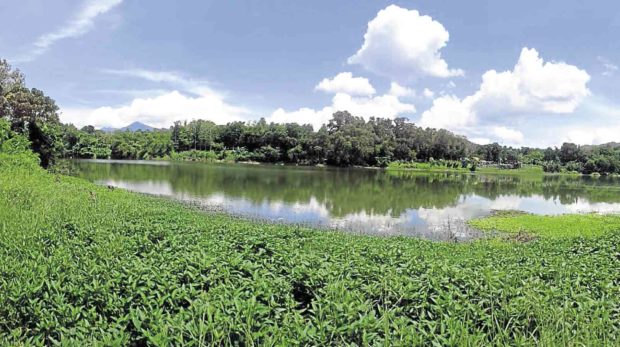Flee mercury-tainted villages, residents told

The pit lake where wastes from the operations of a defunct mining company in Puerto Princesa City were dumped is considered ground zero of mercury contamination in two villages. REDEMPTO D. ANDA
PUERTO PRINCESA CITY—Gerry Valena, a longtime resident of Barangay Sta. Lourdes and head of the local village council’s environment committee, never imagined his community transforming itself into a ghost town, with homes and farms deserted.
Valena had known for a long time about the perils of mercury poisoning and the dreaded Minamata disease, but it was only recently that he and other local officials had been confronted by a most compelling evidence—a recent study by the Department of Health (DOH) indicating that their community was slowly being poisoned with mercury even after mining operations there stopped more than 30 years ago.
Representatives of the DOH and the Department of Environment and Natural Resources (DENR) met with city officials recently to reveal the outcome of tests quantifying the level of mercury contamination affecting the population of roughly 10,000 in the villages of Sta. Lourdes and Tagburos.
The study established that most of these residents had varying levels of poisonous mercury in their bodies.
“Evacuation was proposed during our meeting with national government agencies. Geologists explained the gravity of the situation by pointing out that evacuation must be done now. We were told that areas along the banks of Tagburos River were contaminated with mercury,” Valena said in Filipino.
The national government is recommending an immediate relocation and treatment of residents from selected areas.
Plans are being discussed among city and barangay officials to relocate an initial batch of 80 families that are most exposed to the ground zero of mercury contamination here—
an old mining pit formerly owned by Palawan Quick Silver Mines Inc. (PQMI) and abandoned since 1975.
“If there’s Walking Dead Part 8, it might be here in Sta. Lourdes,” he said in portraying Sta. Lourdes as a possible ghost town, referring to the setting of a popular zombie TV series.
The city government has yet to form a comprehensive response to the recommendations of national government agencies.
However, it has been working with the Mines and Geosciences Bureau (MGB) on a mine rehabilitation program that involved the relocation of residents around the pit lake and the area’s conversion into a “forest park.”
Vice Mayor Nancy Socrates, in a letter to Mayor Luis Marcaida III, urged the creation of a crisis committee to deal with the situation, citing its health and social economic implications.
“The city government needs to have a concrete plan of action. We need to show that we are prepared to do what needs to be done to resolve the PQMI issues for good,” Socrates said.
Lawyer Carlo Gomez, city environment and natural resources officer, said he endorsed the recommendation for evacuation of the area around the pit lake.
Valena said village officials asked the city government and national government for help to undertake a comprehensive medical treatment program for residents, which he said would cost from a low of P30,000 to a high of P200,000 for each patient.
Not all residents, however, are willing and prepared to leave their homes and livelihood.
Many remain unperturbed by the magnitude of the problem, already described by authorities as “reaching crisis proportions.”
“We thought the problem of mercury contamination has already been solved. You see, trees here have grown and we believe that traces of mercury have been flushed out,” said Manuel Dicar, head of the local tour guiding association, Hobbai Inc., in Sta. Lourdes.
Dicar was referring to the rehabilitation done by the government at the wharf, a land feature artificially formed from tons of mercury ore dumped at the bay by PQMI in the 1970s and which now hosts a community of over 300 households, including government-owned structures.
“The economic impact of relocation will be big,” he said.
According to Dicar, people here largely depend on tourism activities around Honda Bay, the second biggest natural attraction in Puerto Princesa City, next only to the famous Underground River.
Dicar admitted, however, that residents living along the coastline of Honda Bay continued to gather marine products that had been identified by the DOH study as a major source of mercury poisoning.
“Many people continue to consume fish harvested from the bay. Our problem is no one bothers to focus on stopping them; people continue to fish and gather shellfish there,” he said.
Valena said the village council’s priority was to provide immediate treatment for residents found to have high levels of mercury in their bodies.
Most residents, he said, were never subjected to medical examination because only those who were identified through random sampling were tested for blood mercury.
“There are children in Sta. Lourdes who grew up showing symptoms of Minamata disease. But we don’t really know because they have not yet been tested,” he said.
A copy of the report’s summary released by the Puerto Princesa government enumerated symptoms of the Minamata disease common among residents tested. Among these are gingivitis, discoloration of gums, nervousness, numbness, headache, palpitations and difficulty in sleeping, difficulty in concentrating, memory loss and respiratory problems.














